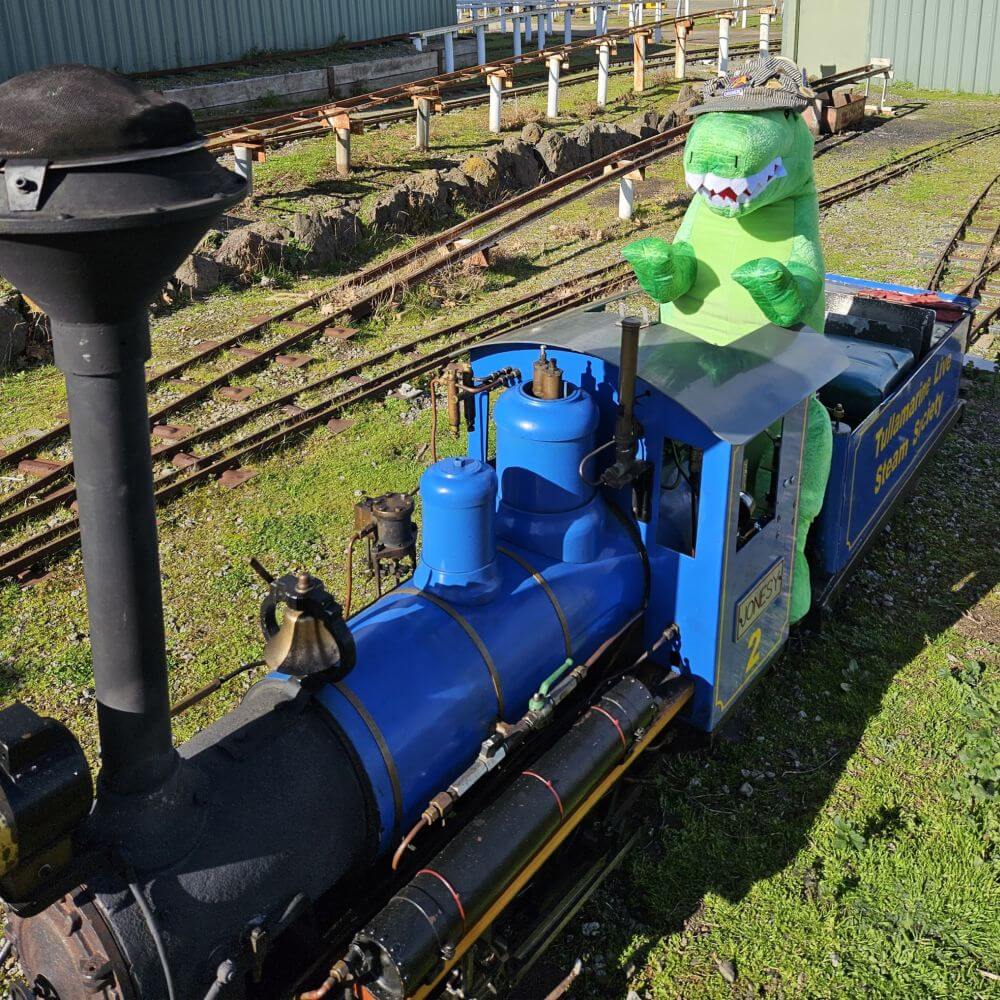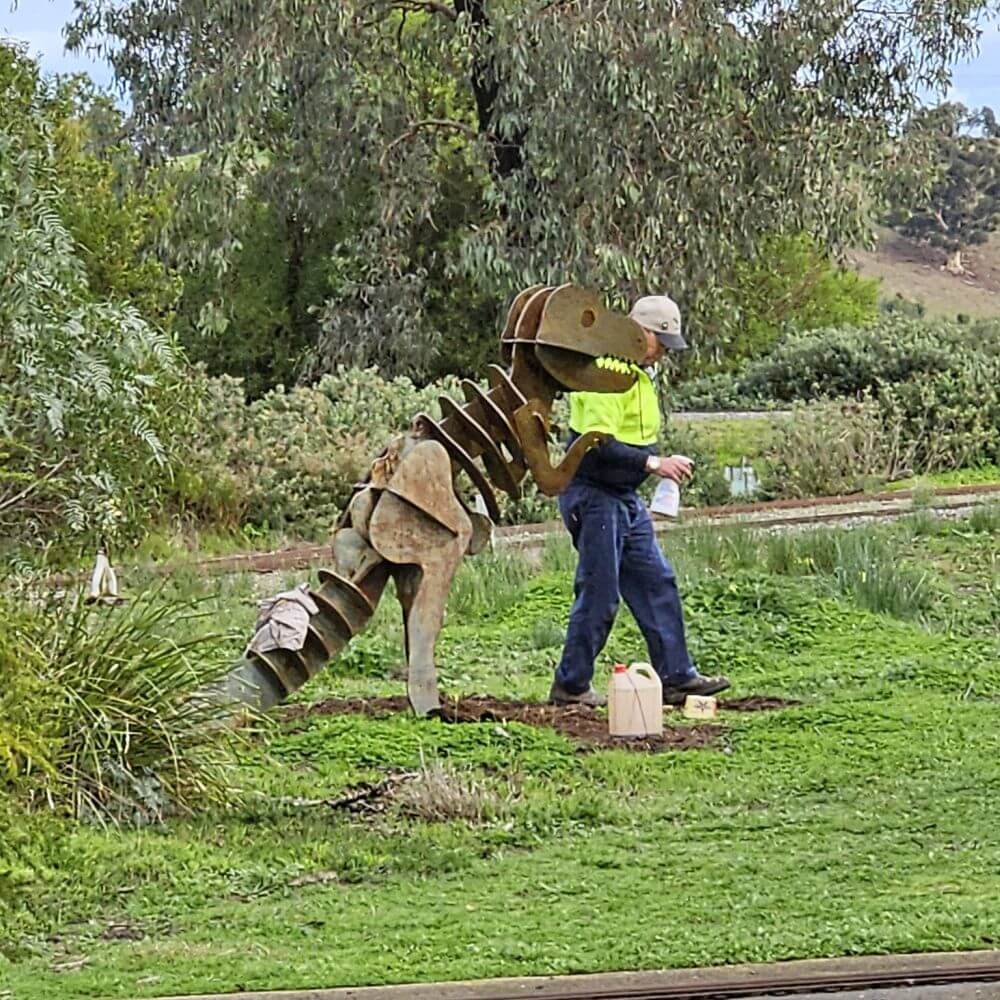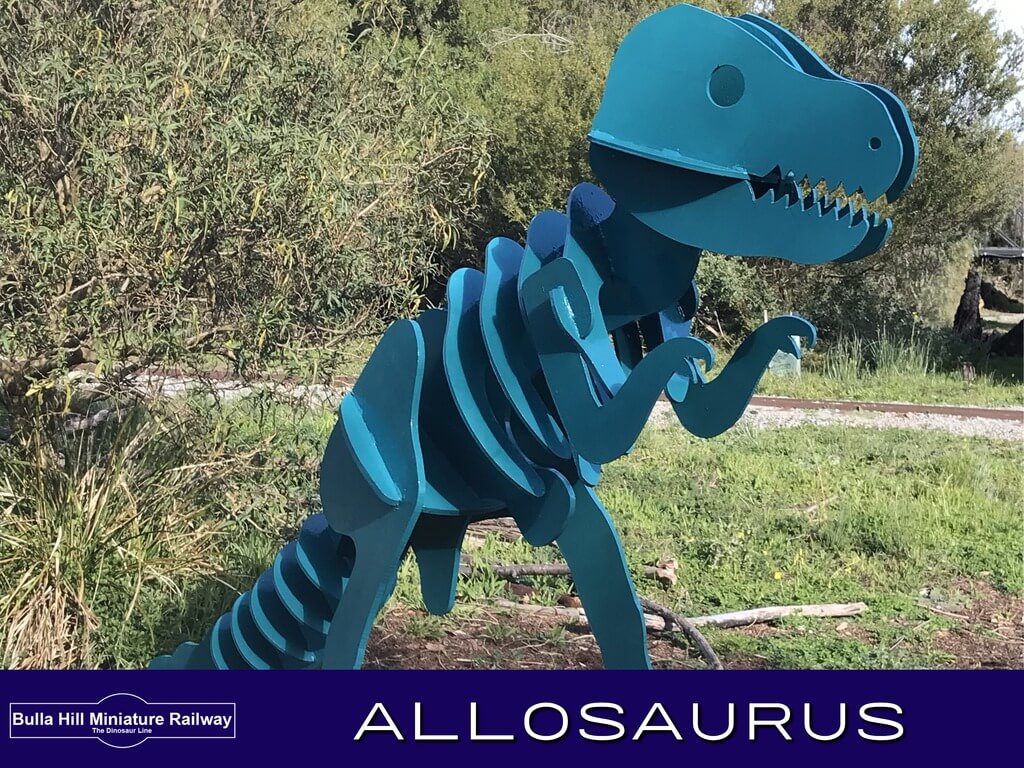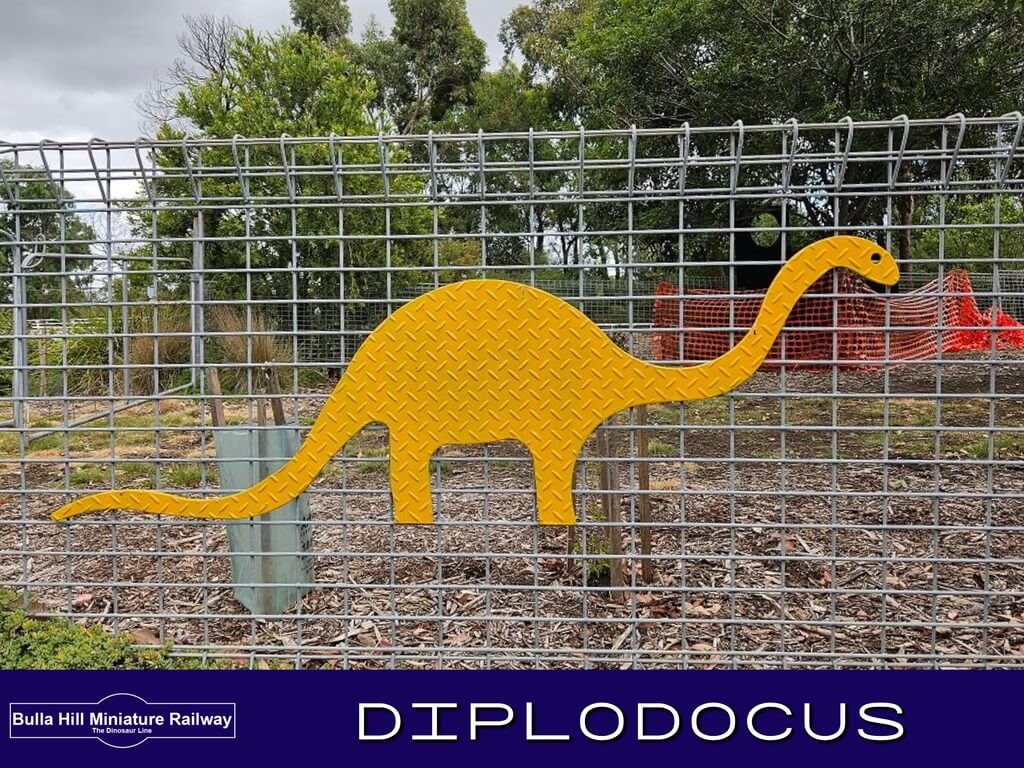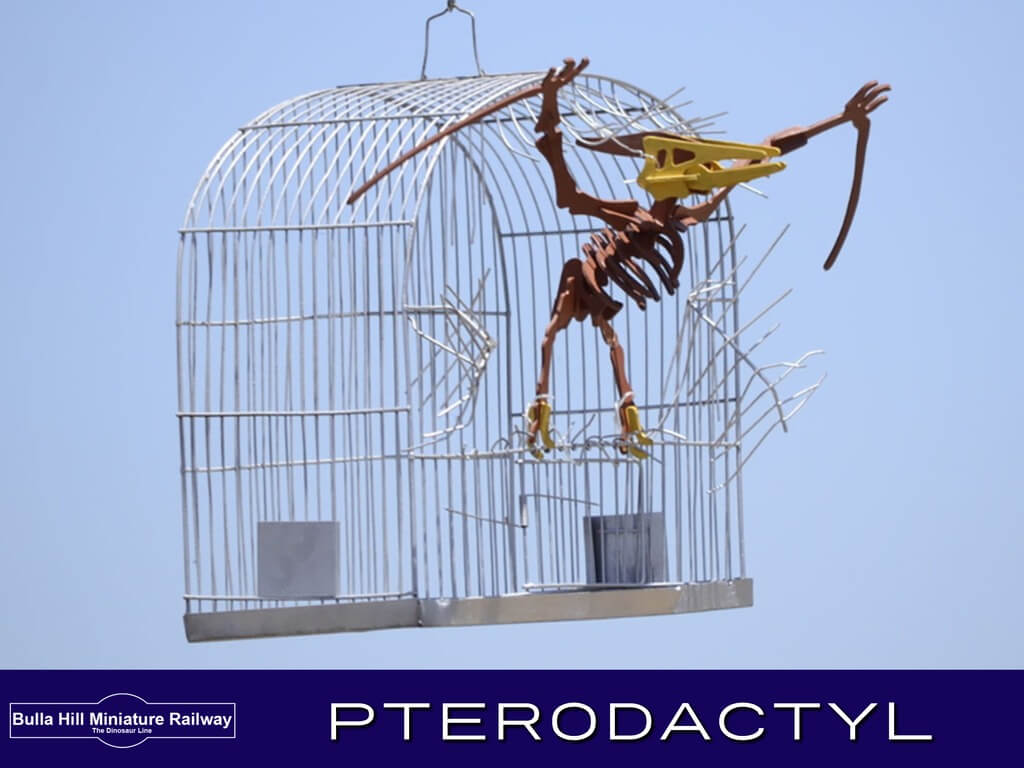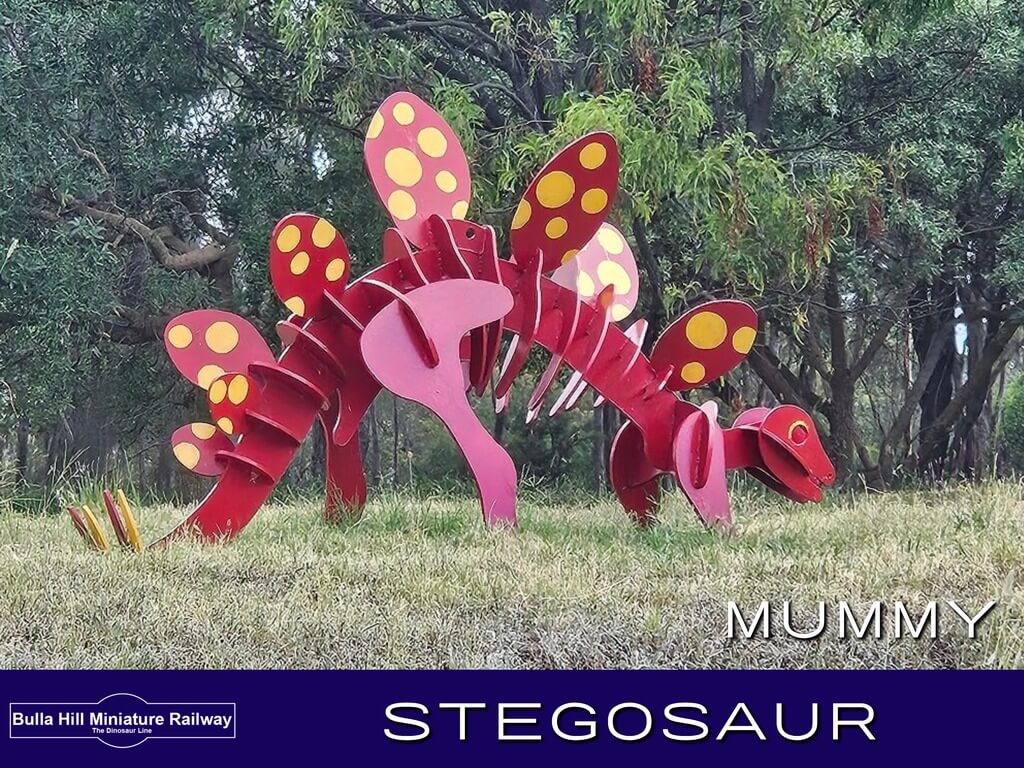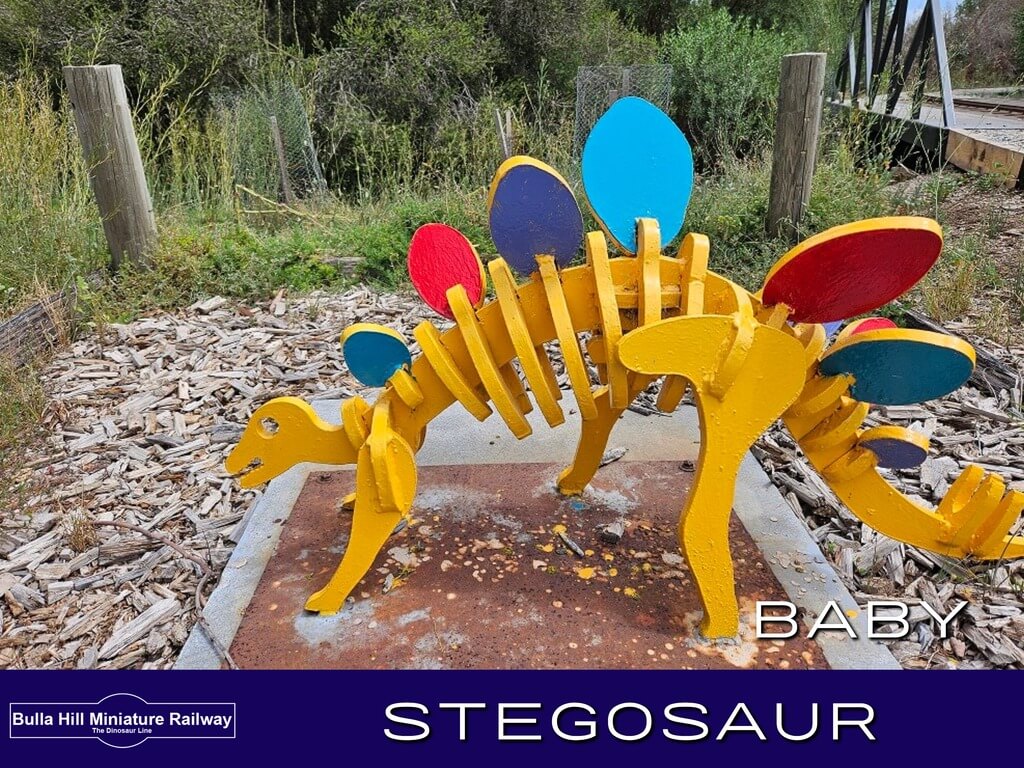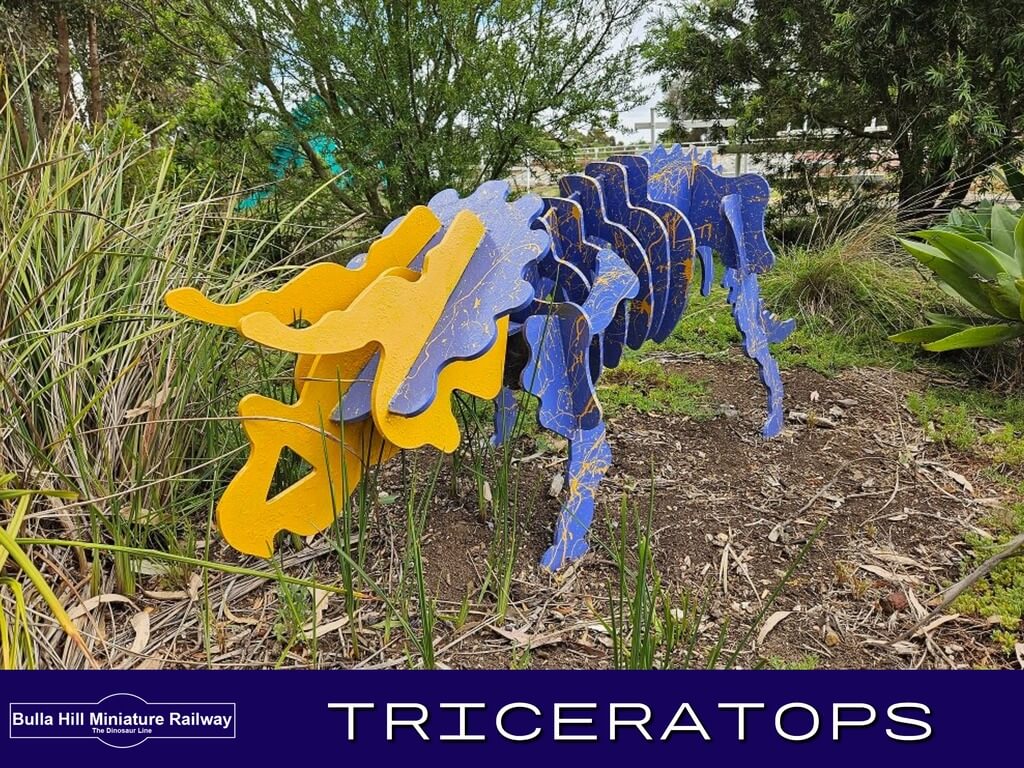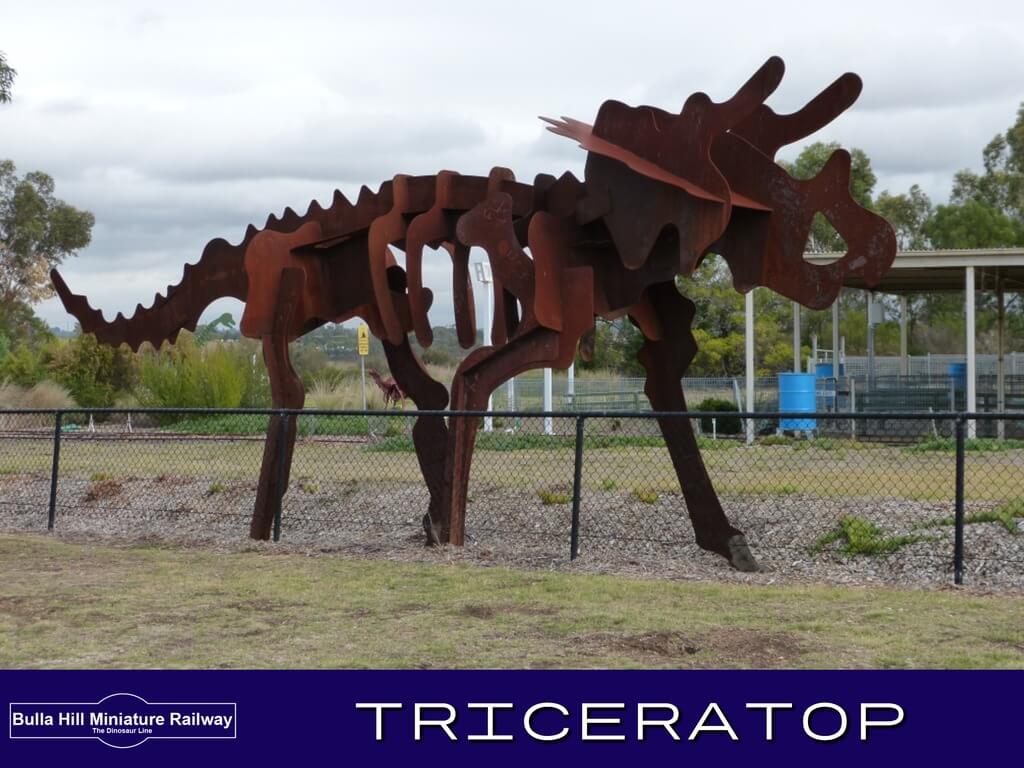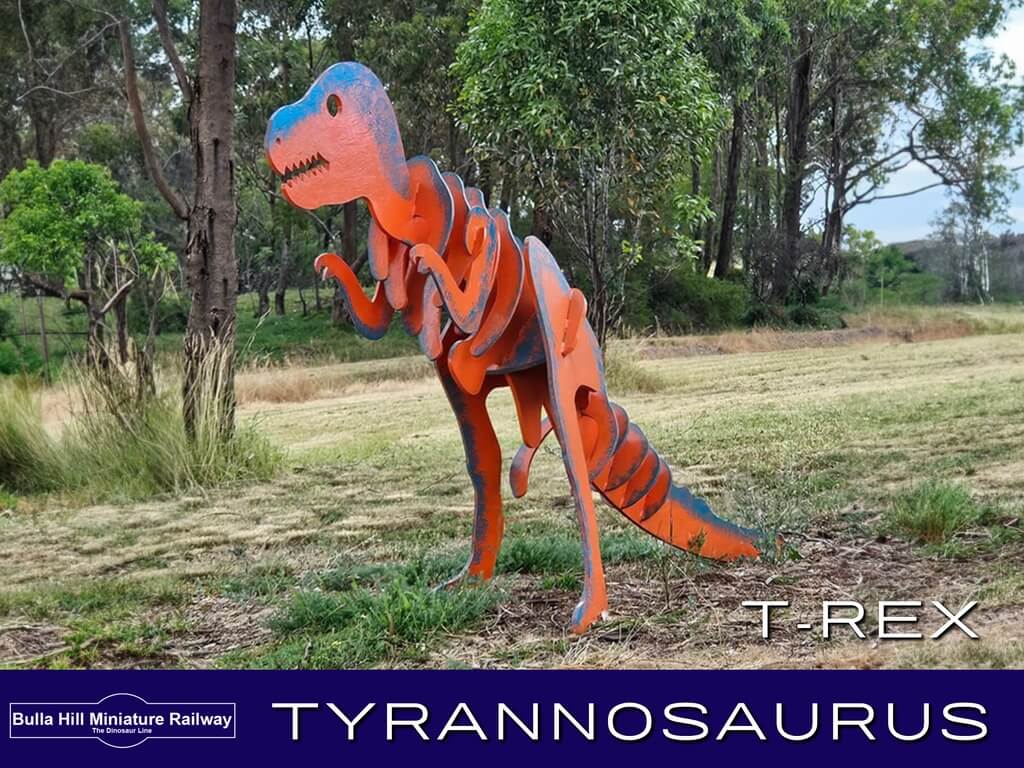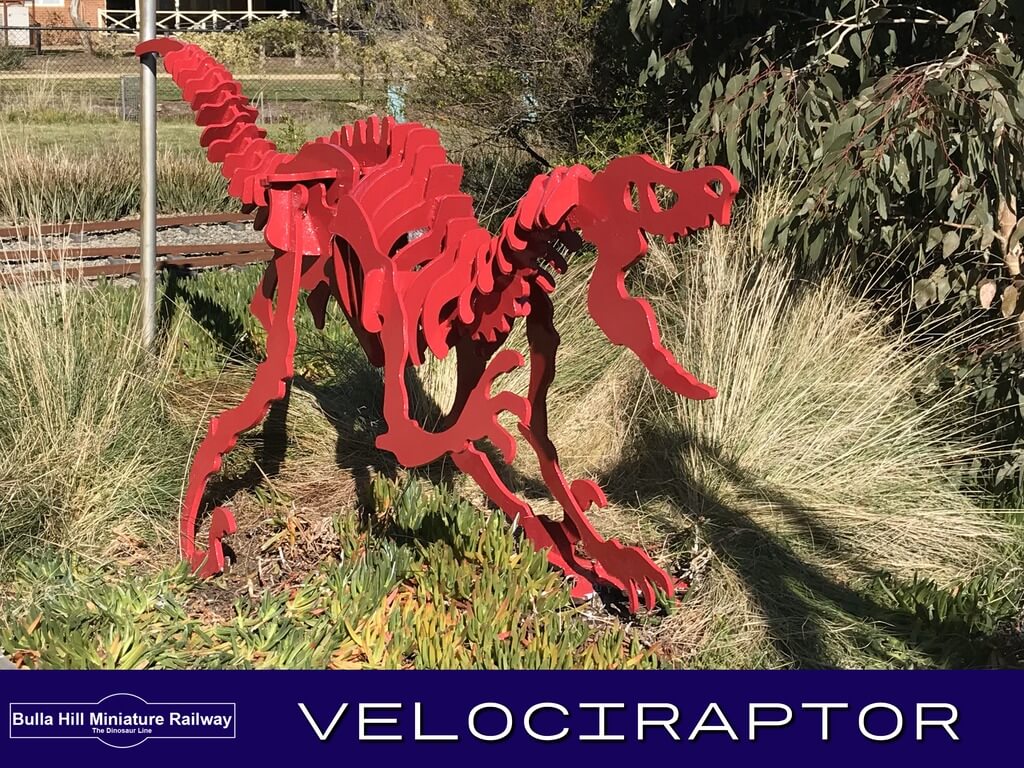Meet Our Dinosaurs
We are located in a large parkland area dedicated to community use. We are between Tullamarine (Melbourne) Airport – 8km after and Sunbury – 11km before.
Shelter Information and Reservations
Allosaurus Fragilis
Allosaurus Fragilis is another big dinosaur, kind of like a T-Rex but not as famous. It’s a meat-eating dinosaur, so it ate other dinosaurs! Imagine a big, scary lizard with sharp teeth and claws.
It was really fast and strong, like a super predator of its time. Allosaurus Fragilis was one of the fiercest hunters in the dinosaur world!
- Allosaurus lived around 150 million years ago in the late Jurassic Period.
- The name Allosaurus means ‘different lizard’.
- Most Allosaurus fossils have been found in the Morrison Formation, a distinctive band of sedimentary rock found in the western United States.
- Allosaurus had a large skull and walked on two legs.
- Its body and head were balanced by a long and heavy tail.
- Like the Tyrannosaurs Rex, the Allosaurus had short arms. It had three fingers that were each tipped with sharp, curved claws.
- Research suggests that the average length of an Allosaurus was around 8.5 metres (28 feet) and that it weighed around 2.3 tons.
- Allosaurus was a carnivore (meat eater) and featured big, sharp teeth that had edges like saws. They were active predators and there is evidence that they attacked Stegosaurus.
Brachiosaurus
Brachiosaurus is a super tall dinosaur with a really long neck, kind of like a giraffe! It’s one of the biggest dinosaurs that ever lived. Picture a giant, gentle giant roaming around and eating leaves from the tallest trees. It’s like the skyscraper of the dinosaur world!
Brachiosaurus was so huge that it needed all that neck to reach the yummy leaves high up in the trees. Isn’t that amazing?
-
The Brachiosaurus is a type of dinosaur known as a Sauropod, they are famous for reaching incredible sizes. Other members of the Sauropod family include the Diplodocus and Apatosaurus.
-
The name Brachiosaurus comes from Greek words meaning ‘arm’ and ‘lizard’. The name refers to the interesting nature of Brachiosaurus legs which were longer at the front than the back.
-
Brachiosaurus lived in North America.
-
The first fossils were found in the Colorado River of the United States of America in 1900. Elmer Riggs first described the giant dinosaur in 1903, calling it “the largest known dinosaur”.
-
The Brachiosaurus had a long neck, a small head and a relatively short tail compared to other Sauropods.
-
The Brachiosaurus walked on all four legs.
-
The weight of Brachiosaurus has been estimated between 30 and 45 metric tons.
-
The length of Brachiosaurus is believed to have been around 26 metres (85 feet).
-
The Brachiosaurus was a herbivore (plant eater), that feed on foliage high above the ground.
-
It is estimated that Brachiosaurus ate between 200 and 400 kilograms (440 and 880 pounds) of plants every day!
-
It wasn’t until 1994 that the original Brachiosaurus fossils found by Elmer Riggs were shown in a museum.
-
An asteroid found in the main asteroid belt of the Solar System was named after the Brachiosaurus.
Diplodocus
Diplodocus is a long-necked dinosaur that’s like a super-sized version of a lizard. It’s not as tall as Brachiosaurus, but it’s still really big! Diplodocus has a really long neck and tail, and it walks on four legs. It’s like the gentle giant of the dinosaur world, munching on plants all day long.
Imagine a huge dinosaur slowly strolling around, looking for tasty leaves to eat. It’s one of the peaceful plant-eaters that lived a long, long time ago!
-
The name Diplodocus comes from the Greek language and means ‘double beam’, this refers to strangely shaped bones found in the Diplodocus tail.
-
The Diplodocus is a well known dinosaur that is popular in films, documentaries, as toy figurines and has been featured in a large number of museum exhibitions around the world.
-
A large amount of fossil remains have made it easier for scientists to study the Diplodocus compared to many other dinosaurs.
-
Diplodocus lived in an area that is now western North America at the end of the Jurassic Period, around 150 million years ago.
-
Although longer dinosaurs have since been discovered, Diplodocus was thought to be the longest for many years.
-
Research suggests the Diplodocus could have been as long as 35m (115ft) and around 10 to 15 tons in weight.
-
Diplodocus had a long tail which contained around 80 vertebrae.
-
Early research suggested the Diplodocus might have swum in water but more recent studies have indicated that water pressure on the chest would have made it too difficult for the Diplodocus to breathe out of its nostrils.
Pterodactyl
Okay, so imagine a dinosaur that can fly! That’s what a Pterodactyl is. It’s not exactly a dinosaur but more like a flying reptile. Picture a big bird with a long beak, but instead of feathers, it has leathery wings like a bat. Pterodactyls soared through the skies like superheroes, looking for food and exploring.
They were really good at flying and could swoop down to catch fish or bugs with their sharp teeth. They’re like the winged wonders of the ancient world!
-
The name Diplodocus comes from the Greek language and means ‘double beam’, this refers to strangely shaped bones found in the Diplodocus tail.
-
The Diplodocus is a well known dinosaur that is popular in films, documentaries, as toy figurines and has been featured in a large number of museum exhibitions around the world.
-
A large amount of fossil remains have made it easier for scientists to study the Diplodocus compared to many other dinosaurs.
-
Diplodocus lived in an area that is now western North America at the end of the Jurassic Period, around 150 million years ago.
-
Although longer dinosaurs have since been discovered, Diplodocus was thought to be the longest for many years.
-
Research suggests the Diplodocus could have been as long as 35m (115ft) and around 10 to 15 tons in weight.
-
Diplodocus had a long tail which contained around 80 vertebrae.
-
Early research suggested the Diplodocus might have swum in water but more recent studies have indicated that water pressure on the chest would have made it too difficult for the Diplodocus to breathe out of its nostrils.
Stegosaurus
Stegosaurus is a dinosaur with a cool set of plates on its back and spikes on its tail. It’s like a walking tank! Picture a big lizard with a row of big plates along its back, kind of like armor. And at the end of its tail, there are sharp spikes for protection. Stegosaurus wasn’t very big compared to some other dinosaurs, but it was still tough!
It mainly ate plants and lived a long time ago when dinosaurs ruled the Earth. It’s one of the most famous dinosaurs because of its unique look with those plates and spikes!
- The Stegosaurus is the most famous dinosaur from a group of dinosaurs known as Stegosauria. They were all herbivores (plant eaters) and featured rows of unique bones that developed into plates and spines along their back and tail.
- The name ‘Stegosaurus’ comes from the Greek words ‘stegos’ meaning roof and ‘sauros’ meaning lizard.
- The Stegosaurus was alive in the late Jurassic Period (around 150 million years ago).
- Stegosaurus fossils have been found in western North America and more recently in Portugal, indicating that they lived in Europe as well.
- In terms of size, the Stegosaurus was large and heavily built. On average, a fully grown Stegosaurus was around 9 metres (30ft) in length, 4 metres (14ft) in height and up to nearly 5 metric tons in weight.
- Although the Stegosaurus body was large, the size of their brain was only around the size of a dog’s.
- Researchers believe that due to the nature of Stegosaurus legs, they had a maximum speed of around 7kph (5mph).
- The 17 plates found along the back of the Stegosaurus arose from the skin rather than being attached to the skeleton. The largest plates were around 60cm (2ft) tall and 60cm (2ft) wide.
- The Stegosaurus also featured tail spikes that reached around 60cm (2ft) to 90cm (3ft) in length.
Triceratops
Triceratops is a big dinosaur that looks a bit like a rhinoceros, but with three horns on its face! Imagine a really tough and sturdy dinosaur with a big frill around its neck, kind of like a collar. Triceratops was like the tank of the dinosaur world, with those horns to defend itself from other dinosaurs. It’s also a plant-eater, munching on leaves and bushes.
So even though it looks fierce, it’s actually a gentle giant, just trying to eat its veggies and stay safe from predators. Triceratops is super famous because of its cool horns and strong appearance!
-
The name ‘Triceratops’ comes from the Greek language, with ‘tri’ meaning three and ‘keratops’ meaning horned face.
- Triceratops lived in the late Cretaceous Period (around 65 million years ago).
-
The Triceratops is one of the most easily recognizable dinosaurs due to its large body, unique frill and three horns.
-
It needed its three horns to try and protect itself from the Tyrannosaurus Rex which lived during the same time period.
-
It is believed that fully grown Triceratops were about 8m (26ft) in length, 3m (10ft) in height and weighed anywhere between 6 to 12 tons (5,500 kg).
-
The skull of a Triceratops alone could grow over 2m (7ft) in length.
-
The Triceratops was a plant eating (herbivore) dinosaur.
-
The first known fossils to be that of a Triceratops were horns attached to a partial skull, found near Denver, Colorado in 1887.
-
Triceratops had anywhere between 400 and 800 teeth, although only a small percentage of these were in use at any one time as they were constantly replaced throughout its lifetime.
-
Triceratops was represented in the popular Transformers toy line and animated series as Slag, an Autobot that could transform into a Triceratops form.
T-Rex
Imagine the biggest, scariest dinosaur you can think of – that’s T-Rex! It’s like the king of the dinosaurs. T-Rex is huge, with big sharp teeth and tiny arms. It’s like a giant monster straight out of a movie! T-Rex was a meat-eater, so it liked to hunt other dinosaurs for dinner.
It could run really fast and had a super powerful bite. But even though T-Rex was really scary, it’s also super famous and cool! Kids love T-Rex because it’s like the ultimate dinosaur adventure.
- ‘Tyrannosaurus’ comes from the Greek words meaning ‘tyrant lizard’, while the word ‘rex’ means ‘king’ in Latin.
- Tyrannosaurus Rex is often abbreviated to T-Rex.
- Tyrannosaurus Rex lived in an area of the Earth that now makes up western North America.
- Tyrannosaurus Rex walked on two legs, balancing its huge head with a long and heavy tail that sometimes contained over 40 vertebrae.
- Tyrannosaurus Rex measured up to 13m (42ft) in length, 4m (13ft) at the hip and could weigh up to 7 tons!
- The skull of a Tyrannosaurus Rex alone measured up to 1.5m (5ft) long.
- The largest tooth of any carnivorous dinosaur found to this date is that of a T-Rex. It is estimated to have been around 30cm (12in) long when including the root.
- When Tyrannosaurus Rex hit around the age of 14 its body size would increase rapidly, putting on around 600kg (1300lb) a year over the next 4 years.
- Tyrannosaurus Rex had small arms that were extremely powerful and featured two clawed fingers.
- Tyrannosaurus Rex lived in the late Cretaceous Period, around 66 million years ago.
- Because of the lack of concrete evidence, it is difficult for scientists to work out how fast Tyrannosaurus Rex could run, with estimates ranging from as low as 17kph (11mph) to as high as 70kph (43mph). Average estimates suggest a max speed of around 40kph (25mph).
- There is also strong debate about whether Tyrannosaurus Rex was a predator or scavenger. It had small arms which would have made it hard to grip prey, suggesting it may have been a scavenger. On the other hand, evidence in favour of it being a predator includes its forward pointing eyes which give better depth perception and make it easier to hunt.
Velociraptor
Velociraptor is a dinosaur that’s small but super fast and clever! Picture a feathery lizard with a long tail, sharp claws, and a pointy snout. Velociraptors were like the ninjas of the dinosaur world! They hunted in packs, working together to catch their prey. Even though they were small, they were really smart and could outsmart bigger dinosaurs.
Velociraptor is famous because it’s so cool and fast, like a speedy little dinosaur with a big attitude!
- The name Velociraptor means ‘swift seizer’.
- Velociraptor lived in the late Cretaceous Period (around 73 million years ago).
- The Velociraptor played a large role in the Jurassic Park movies but was often shown inaccurately. Rather than being a larger, human sized dinosaur, the Velociraptor was around the size of a Turkey. It is also believed to have had feathers that were not shown in the movie portrayal.
- A fully grown Velociraptor could grow up to 2m (6.6ft) in length, 0.5m (1.6ft) in height at the hip and weigh up to 15kg (33lb).
- The Velociraptor is thought to have killed its prey with sickle shaped claws on its rear feet.
- The first known Velociraptor fossil was found in the Mongolian Gobi Desert in 1922.
- One of the most famous dinosaur fossils ever found features a Velociraptor in the middle of battle with a Protoceratops.


